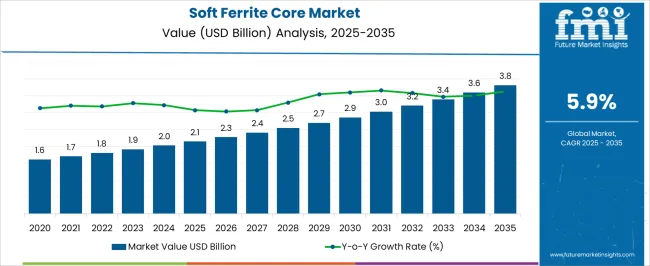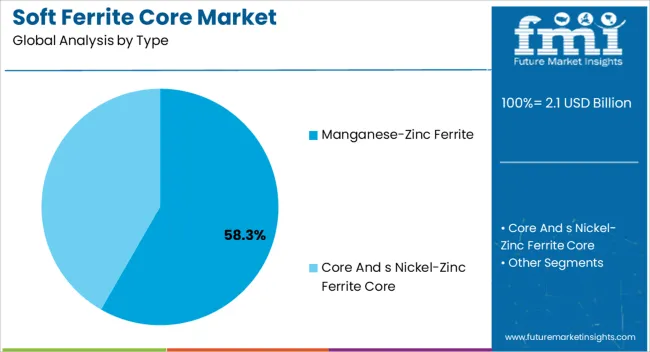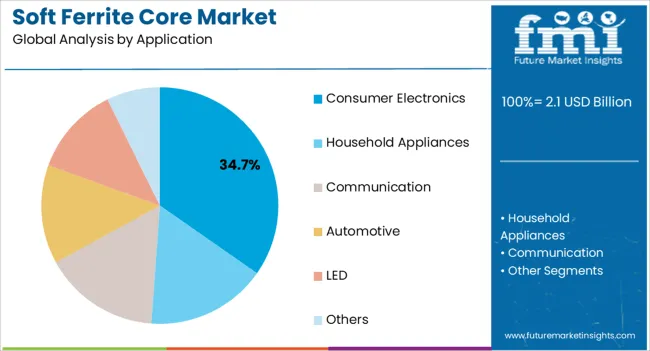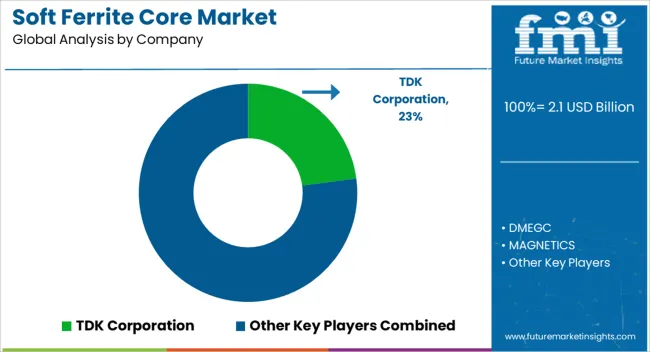The Soft Ferrite Core Market is estimated to be valued at USD 2.1 billion in 2025 and is projected to reach USD 3.8 billion by 2035, registering a compound annual growth rate (CAGR) of 5.9% over the forecast period.

| Metric | Value |
|---|---|
| Soft Ferrite Core Market Estimated Value in (2025 E) | USD 2.1 billion |
| Soft Ferrite Core Market Forecast Value in (2035 F) | USD 3.8 billion |
| Forecast CAGR (2025 to 2035) | 5.9% |
The soft ferrite core market is expanding steadily due to increasing demand for efficient power conversion, miniaturization of electronic devices, and the rising adoption of high frequency transformers and inductors. Growing penetration of consumer electronics, renewable energy systems, and electric vehicles is creating strong growth opportunities for ferrite cores that provide low losses and high magnetic permeability.
Continuous advancements in material science are enabling improved thermal stability and performance consistency, making soft ferrite cores indispensable in modern electronics. Regulatory focus on energy efficiency and the global push toward electrification are further reinforcing adoption.
The outlook remains positive as manufacturers invest in developing high performance ferrites that support next generation electronics and green energy applications.

The manganese zinc ferrite segment is projected to contribute 58.30% of total market revenue by 2025 within the type category, positioning it as the leading segment. Its dominance is attributed to superior magnetic properties, high permeability, and low core loss characteristics, making it well suited for applications in transformers, inductors, and power supply components.
This segment has benefited from strong demand in power electronics and consumer devices where efficiency and compactness are critical. The capability of manganese zinc ferrite to operate effectively across a wide frequency range has further solidified its adoption.
With increasing requirements for miniaturized and high efficiency electronic systems, manganese zinc ferrite continues to hold the largest market share in the type category.

The consumer electronics segment is expected to account for 34.70% of total market revenue by 2025 under the application category, establishing it as the leading end use sector. Growth is being driven by the rising consumption of smartphones, laptops, televisions, and other portable electronic devices that require high performance magnetic components.
The demand for energy efficient and lightweight devices has reinforced the use of soft ferrite cores in chargers, adapters, and audio systems. Furthermore, rapid technological advancements in electronics manufacturing and increasing consumer spending on smart devices are contributing to higher adoption.
As the consumer electronics industry continues to expand globally, the requirement for reliable and cost effective ferrite cores is expected to remain strong, maintaining this segment’s leadership in the application category.
The market is estimated to register a CAGR of 4.1%, with a valuation of USD 1.6 billion in 2020 and USD 2.1 billion in 2025.
Soft ferrite cores are widely used in various applications, including consumer electronics, automotive electronics, power supplies, telecommunications, and renewable energy systems. These cores provide high magnetic permeability and low electrical conductivity, making them suitable for applications where electromagnetic interference (EMI) suppression and efficient energy conversion are essential.
Between 2020 and 2025, the soft ferrite core market experienced steady growth due to increasing demand from sectors such as automotive electronics, industrial automation, and renewable energy. The growing adoption of electric vehicles (EVs), the expansion of 5G infrastructure, and the rising demand for renewable energy sources were among the key drivers for the market.
Additionally, the proliferation of smart devices, IoT (Internet of Things) applications, and the increasing need for high-frequency transformers and inductors also contributed to the demand for soft ferrite cores during this period.
Based on application, consumer electronics dominate the ferrite core market. Consumer electronics is estimated to secure a share of 33.1% in the global market by 2035.
Consumer electronics indeed represent a significant application segment in the ferrite core market. Soft ferrite cores are widely used in consumer electronic devices, including electromagnetic interference (EMI) suppression, power supply filtering, and noise reduction. Some common consumer electronics applications where ferrite cores are utilized include:
| Countries | Forecast Share (2025 To 2035) |
|---|---|
| United States | 18.7% |
| Germany | 9.1% |
| Japan | 4.7% |
| Australia | 3.9% |
| Countries | Forecast CAGR (2025 To 2035) |
|---|---|
| China | 5.6% |
| India | 8.7% |
| United Kingdom | 4.3% |
Due to an increase in the manufacture of electrical equipment in the region, North America is anticipated to get hold of a soft ferrite core market share of 42.2% in 2025.
The market in the region is also influenced by significant regional market players in the electrical sector, like General Electric, who exhibit an increase in soft ferrite core usage. Along with these factors, the region's market is also being driven by government initiatives for rapid economic expansion, energy-efficient appliances, changes in consumer lifestyles, and many manufacturers' existence.
The demand for electronic equipment has soared due to a high level of living and an increase in disposable income, and the same are expected to contribute to Europe's 21.1% market share in 2025.
Additionally, the need for RADAR systems has expanded across the region due to economic and security concerns, particularly in the aerospace and defence sectors, which is expanding the soft ferrite core market size. On the other hand, prices jumped to USD 95 per ton in markets based on the dollar in Europe, or €90 per ton, and the same is likely to dwindle in the market in Europe.

In general, the soft ferrite core market is fairly consolidated. Major manufacturers are seen engaging in product development, intensive research, and customization of their offerings to specialized and promising applications to augment their market share.
One of the tier 1 players is Toshiba Corp (Toshiba Materials Co., Ltd.), followed by Hitachi Metals Ltd. and Voestalpine Stahl GmbH. They are expected to hold a combined market share of more than 50% worldwide. Another prominent start-up in the market can be Viona Magnetics, which was founded in 1999. It provides services for the military, medical, broadcast, aerospace, automobile, electronics, and telecommunications sectors.
Like in several other industrial sectors, numerous start-ups have come up to compete with present-day soft ferrite core market players by adopting the newest technologies. For instance, a custom maker of ceramic magnets with barium or strontium ferrite magnet cores is available for use in loudspeakers, motors, craft projects, and toys.
Magnet cores are brittle and resistant to demagnetization. Pressing, sintering, injection moulding, assembling, surface treatment, machining, magnetizing, and handling are among the capabilities. Well-known manufacturers have also demonstrated the use of inorganic techniques.
Hybrid Electronics, an emerging start-up founded in 2005 at Stanford, is the EMI ferrite core distributor for wiring and cables. A few examples of secondary services are reeling, testing, retaining, up screening, and encapsulation or counterfeit detection.
Other Essential Players in the Global Market are:
Recent Developments in Soft Ferrite Core Market are as follows:
| Attribute | Details |
|---|---|
| Forecast Period | 2025 to 2035 |
| Historical Data Available for | 2020 to 2025 |
| Market Analysis | USD billion for Value |
| Key Countries Covered | United States, United Kingdom, Japan, India, China, Australia, Germany |
| Key Segments Covered | Type, Application, Region |
| Key Companies Profiled | TDK Corporation; DMEGC; MAGNETICS; Acme Electronics; Hitachi metals Ltd.; Ferroxcube International Holding B.V.; HEC Group; Toshiba materials Co. Ltd.; SAMWHA Electric. |
| Report Coverage | Market Forecast, Company Share Analysis, Competition Intelligence, DROT Analysis, Market Dynamics and Challenges, and Strategic Growth Initiatives |
| Customization & Pricing | Available upon Request |
The global soft ferrite core market is estimated to be valued at USD 2.1 billion in 2025.
The market size for the soft ferrite core market is projected to reach USD 3.8 billion by 2035.
The soft ferrite core market is expected to grow at a 5.9% CAGR between 2025 and 2035.
The key product types in soft ferrite core market are manganese-zinc ferrite and core and s nickel-zinc ferrite core.
In terms of application, consumer electronics segment to command 34.7% share in the soft ferrite core market in 2025.






Our Research Products

The "Full Research Suite" delivers actionable market intel, deep dives on markets or technologies, so clients act faster, cut risk, and unlock growth.

The Leaderboard benchmarks and ranks top vendors, classifying them as Established Leaders, Leading Challengers, or Disruptors & Challengers.

Locates where complements amplify value and substitutes erode it, forecasting net impact by horizon

We deliver granular, decision-grade intel: market sizing, 5-year forecasts, pricing, adoption, usage, revenue, and operational KPIs—plus competitor tracking, regulation, and value chains—across 60 countries broadly.

Spot the shifts before they hit your P&L. We track inflection points, adoption curves, pricing moves, and ecosystem plays to show where demand is heading, why it is changing, and what to do next across high-growth markets and disruptive tech

Real-time reads of user behavior. We track shifting priorities, perceptions of today’s and next-gen services, and provider experience, then pace how fast tech moves from trial to adoption, blending buyer, consumer, and channel inputs with social signals (#WhySwitch, #UX).

Partner with our analyst team to build a custom report designed around your business priorities. From analysing market trends to assessing competitors or crafting bespoke datasets, we tailor insights to your needs.
Supplier Intelligence
Discovery & Profiling
Capacity & Footprint
Performance & Risk
Compliance & Governance
Commercial Readiness
Who Supplies Whom
Scorecards & Shortlists
Playbooks & Docs
Category Intelligence
Definition & Scope
Demand & Use Cases
Cost Drivers
Market Structure
Supply Chain Map
Trade & Policy
Operating Norms
Deliverables
Buyer Intelligence
Account Basics
Spend & Scope
Procurement Model
Vendor Requirements
Terms & Policies
Entry Strategy
Pain Points & Triggers
Outputs
Pricing Analysis
Benchmarks
Trends
Should-Cost
Indexation
Landed Cost
Commercial Terms
Deliverables
Brand Analysis
Positioning & Value Prop
Share & Presence
Customer Evidence
Go-to-Market
Digital & Reputation
Compliance & Trust
KPIs & Gaps
Outputs
Full Research Suite comprises of:
Market outlook & trends analysis
Interviews & case studies
Strategic recommendations
Vendor profiles & capabilities analysis
5-year forecasts
8 regions and 60+ country-level data splits
Market segment data splits
12 months of continuous data updates
DELIVERED AS:
PDF EXCEL ONLINE
Software-Defined Wide Area Network Market Size and Share Forecast Outlook 2025 to 2035
Soft Start Resistor Market Size and Share Forecast Outlook 2025 to 2035
Soft Touch Lamination Film Market Size and Share Forecast Outlook 2025 to 2035
Core Plate Varnishes Market Size and Share Forecast Outlook 2025 to 2035
Software Defined Vehicle Market Size and Share Forecast Outlook 2025 to 2035
Software Defined Networking (SDN) And Network Function Virtualization (NFV) Market Size and Share Forecast Outlook 2025 to 2035
Software Defined Perimeter (SDP) Market Size and Share Forecast Outlook 2025 to 2035
Soft Gripper Market Size and Share Forecast Outlook 2025 to 2035
Software-Defined Wide Area Network SD-WAN Market Size and Share Forecast Outlook 2025 to 2035
Soft Magnetic Composite Market Analysis - Size, Share, and Forecast Outlook 2025 to 2035
Softwood Veneer and Plywood Market Size and Share Forecast Outlook 2025 to 2035
Software Defined Radio (SDR) Market Size and Share Forecast Outlook 2025 to 2035
Software License Management (SLM) Market Size and Share Forecast Outlook 2025 to 2035
Soft Wall Military Shelter Market Size and Share Forecast Outlook 2025 to 2035
Software-Defined Networking SDN Market Size and Share Forecast Outlook 2025 to 2035
Soft Drinks Packaging Market Size and Share Forecast Outlook 2025 to 2035
Software-Defined Anything (SDx) Market Size and Share Forecast Outlook 2025 to 2035
Software-Defined Data Center Market Size and Share Forecast Outlook 2025 to 2035
Software Containers Market Size and Share Forecast Outlook 2025 to 2035
Software Defined Application And Infrastructure Market Size and Share Forecast Outlook 2025 to 2035

Thank you!
You will receive an email from our Business Development Manager. Please be sure to check your SPAM/JUNK folder too.
Chat With
MaRIA